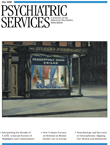May 2008: This Month's Highlights
Special Section: Interpretingthe CATIE Findings
In September 2005 the initial report of findings from the Clinical Antipsychotic Trials of Intervention Effectiveness (CATIE) indicated that costly second-generation antipsychotics were no more effective than a first-generation agent. Advocacy groups despaired that these findings would buttress attempts to limit access to the newer agents, and much debate has since ensued about how best to interpret these findings in everyday practice. A special section of nine articles in this month's issue offers clinicians and other stakeholders some much-needed neutral commentary—free of the "thinly veiled industry spin" that has characterized much of the debate about the CATIE findings, according to Marvin S. Swartz, M.D., who served as guest editor of the special section. The first article provides an overview of the CATIE design and main outcomes ( Original article: page 500 ). The second article reports results of an analysis of national data to determine trends over ten years in first- and second-generation antipsychotic use and changes in user characteristics ( Original article: page 507 ). The third article discusses the intersection of the science of cost-effectiveness with policy and political decision making in regard to CATIE and suggests methods to better align formularies with evidence from cost-effectiveness studies ( Original article: page 515 ). The fourth article, a commentary, urges caution on use of CATIE as the cornerstone of new formulary policies ( Original article: page 521 ). The fifth article examines take-home lessons from CATIE, underscoring the importance of approaches to prescribing that optimize individual benefit-risk profiles ( Original article: page 523 ). The authors of the sixth article discuss CATIE implications from the perspective of mental health services researchers, eschewing interpretations that would support "fail-first" formulary policies ( Original article: page 526 ). In the seventh article, a clinical researcher from the United Kingdom welcomes the eroding distinction between first- and second-class agents and the end of the preferred status of the newer drugs ( Original article: page 530 ). The final two articles summarize perspectives of two other stakeholder groups—state mental health policy makers ( Original article: page 534 ) and patient advocacy groups ( Original article: page 537 ). As Dr. Swartz notes in his introduction to the special section ( Original article: page 497 ) the most enduring lesson from CATIE "is the need to critically and dispassionately evaluate unbiased empirical data and use the best tools available to drive evidence-based policy and practice." In addition, during the past six months when the special section was in review, the journal accepted three reports on trends in antipsychotic use in the era of second-generation agents—one from the United States ( Original article: page 540 ), one from Canada ( Original article: page 547 ), and one from the Netherlands ( Original article: page 554 )—reflecting the ongoing and international focus on this important issue.
Aligning Science and Recovery in Schizophrenia
The lead article, by several influential thinkers and researchers in the field of schizophrenia treatment, shows how two models of this disease—the "broken brain" model and the "recovery" model—are not as contradictory as they might seem. Jeffrey A. Lieberman, M.D., and coauthors note that the tension between neuroscientists' emphasis on brain pathologies and advocates' emphasis on recovery arises from lack of definitional clarity. They suggest defining recovery in terms of a range of improvements in specific domains, such as "recovery of cognitive functioning" or "recovery of vocational functioning," which will permit clinicians to communicate more clearly regarding research findings and treatment goals. The article examines and links new findings in neurobiology and recovery. The authors conclude that "an operational definition of recovery allows for bridging hope and recovery with important advances in the science of the brain" ( Original article: page 487 ).
Mental Health Services in Europe
In this issue the journal introduces a column focusing on mental health care reforms in Europe. Matt Muijen, M.D., Ph.D., who is regional adviser for mental health for the World Health Organization's Regional Office for Europe, is column editor. In his introductory installment, Dr. Muijen provides an overview of changes in services across Europe, largely driven by political commitment at national and intergovernmental levels in response to public health challenges posed by mental health problems. He emphasizes the wide diversity across Europe, which includes highly developed Western European countries and former Soviet Union republics, and the urgent need for comparable data ( Original article: page 479 ). A brief report by Stefan Priebe, Dr.Med.Habil., and colleagues presents data that appear to indicate an increase in institutional care across nine European countries ( Original article: page 570 ). In a commentary, Dr. Muijen urges caution in interpreting these data ( Original article: page 574 ).



